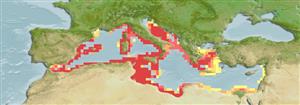Common names from other countries
Classification / Names / Names
Namen | Synonyme | Catalog of Fishes (gen., sp.) | ITIS | CoL | WoRMS
Environment: milieu / climate zone / depth range / distribution range
Ökologie
; tiefenbereich 0 - 250 m (Ref. 85345). Subtropical
Atlantic and the Mediterranean Sea: Algeria.
Length at first maturity / Size / Gewicht / Alter
Maturity: Lm ? range ? - ? cm Max length : 20.0 cm TL Männchen/unbestimmt; (Ref. 358)
Maximum size: 20 cm. Body: with more or less round cross section; is provided with the ventral face with 3 lines with podia with suction cups. Tegument: constellated with multiple papillae. Color: supported black; papillae being very of an immaculate white. Absence of tubes of Vat (Ref. 358).
Maximum size: 20 cm. Species presents the small funds until largest the depths, but rare. Habitat: Hard funds and herbaria. Biology: this species is nourished, using its tentacles oral flattened, of various organic fragments. It (charges) literally elements of the ground in its oral opening, located at the back of the body. The animal sorts the edible organic substances, and rejects the elements not metabolized such as sand, in the form of roved excrements (Ref. 358).
Life cycle and mating behavior
Geschlechtsreife | Fortpflanzung | Ablaichen | Eier | Fecundity | Larven
Members of the class Holothuroidea are gonochoric and have only one gonad. Spawning and fertilization are both external and some exhibit brooding. Life cycle: Embryos develop into planktotrophic larvae (auricularia) then into doliolaria (barrel-shaped stage) which later metamorphose into juvenile sea cucumbers.
Göthel, H. 1992. (Ref. 358)
IUCN Rote Liste Status (Ref. 130435)
CITES Status (Ref. 108899)
Not Evaluated
Not Evaluated
Nutzung durch Menschen
| FishSource |
Tools
Internet Quellen
Estimates based on models
Preferred temperature
(Ref.
115969): 13.3 - 18.4, mean 14.9 (based on 106 cells).
Widerstandsfähigkeit
hoch, Verdopplung der Population dauert weniger als 15 Monate. (K=0.69).
Verwundbarkeit
Low vulnerability (10 of 100).
Preiskategorie
Unknown.
